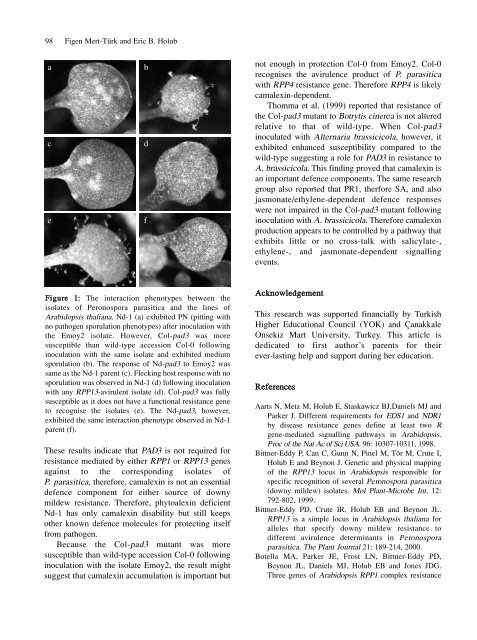Full Journal - Journal of Cell and Molecular Biology - Haliç Üniversitesi
Full Journal - Journal of Cell and Molecular Biology - Haliç Üniversitesi
Full Journal - Journal of Cell and Molecular Biology - Haliç Üniversitesi
You also want an ePaper? Increase the reach of your titles
YUMPU automatically turns print PDFs into web optimized ePapers that Google loves.
98 Figen Mert-Türk <strong>and</strong> Eric B. Holub<br />
a b<br />
c d<br />
e f<br />
Figure 1: The interaction phenotypes between the<br />
isolates <strong>of</strong> Peronospora parasitica <strong>and</strong> the lines <strong>of</strong><br />
Arabidopsis thaliana. Nd-1 (a) exhibited PN (pitting with<br />
no pathogen sporulation phenotypes) after inoculation with<br />
the Emoy2 isolate. However, Col-pad3 was more<br />
susceptible than wild-type accession Col-0 following<br />
inoculation with the same isolate <strong>and</strong> exhibited medium<br />
sporulation (b). The response <strong>of</strong> Nd-pad3 to Emoy2 was<br />
same as the Nd-1 parent (c). Flecking host response with no<br />
sporulation was observed in Nd-1 (d) following inoculation<br />
with any RPP13-avirulent isolate (d). Col-pad3 was fully<br />
susceptible as it does not have a functional resistance gene<br />
to recognise the isolates (e). The Nd-pad3, however,<br />
exhibited the same interaction phenotype observed in Nd-1<br />
parent (f).<br />
These results indicate that PAD3 is not required for<br />
resistance mediated by either RPP1 or RPP13 genes<br />
against to the corresponding isolates <strong>of</strong><br />
P. parasitica, therefore, camalexin is not an essential<br />
defence component for either source <strong>of</strong> downy<br />
mildew resistance. Therefore, phytoalexin deficient<br />
Nd-1 has only camalexin disability but still keeps<br />
other known defence molecules for protecting itself<br />
from pathogen.<br />
Because the Col-pad3 mutant was more<br />
susceptible than wild-type accession Col-0 following<br />
inoculation with the isolate Emoy2, the result might<br />
suggest that camalexin accumulation is important but<br />
not enough in protection Col-0 from Emoy2. Col-0<br />
recognises the avirulence product <strong>of</strong> P. parasitica<br />
with RPP4 resistance gene. Therefore RPP4 is likely<br />
camalexin-dependent.<br />
Thomma et al. (1999) reported that resistance <strong>of</strong><br />
the Col-pad3 mutant to Botrytis cinerea is not altered<br />
relative to that <strong>of</strong> wild-type. When Col-pad3<br />
inoculated with Alternaria brassicicola, however, it<br />
exhibited enhanced susceptibility compared to the<br />
wild-type suggesting a role for PAD3 in resistance to<br />
A. brassicicola. This finding proved that camalexin is<br />
an important defence components. The same research<br />
group also reported that PR1, therfore SA, <strong>and</strong> also<br />
jasmonate/ethylene-dependent defence responses<br />
were not impaired in the Col-pad3 mutant following<br />
inoculation with A. brassicicola. Therefore camalexin<br />
production appears to be controlled by a pathway that<br />
exhibits little or no cross-talk with salicylate-,<br />
ethylene-, <strong>and</strong> jasmonate-dependent signalling<br />
events.<br />
Acknowledgement<br />
This research was supported financially by Turkish<br />
Higher Educational Council (YOK) <strong>and</strong> Çanakkale<br />
Onsekiz Mart University, Turkey. This article is<br />
dedicated to first author’s parents for their<br />
ever-lasting help <strong>and</strong> support during her education.<br />
References<br />
Aarts N, Metz M, Holub E, Staskawicz BJ,Daniels MJ <strong>and</strong><br />
Parker J. Different requirements for EDS1 <strong>and</strong> NDR1<br />
by disease resistance genes define at least two R<br />
gene-mediated signalling pathways in Arabidopsis.<br />
Proc <strong>of</strong> the Nat Ac <strong>of</strong> Sci USA. 96: 10307-10311, 1998.<br />
Bittner-Eddy P, Can C, Gunn N, Pinel M, Tör M, Crute I,<br />
Holub E <strong>and</strong> Beynon J. Genetic <strong>and</strong> physical mapping<br />
<strong>of</strong> the RPP13 locus in Arabidopsis responsible for<br />
specific recognition <strong>of</strong> several Peronospora parasitica<br />
(downy mildew) isolates. Mol Plant-Microbe Int. 12:<br />
792-802, 1999.<br />
Bittner-Eddy PD, Crute IR, Holub EB <strong>and</strong> Beynon JL.<br />
RPP13 is a simple locus in Arabidopsis thaliana for<br />
alleles that specify downy mildew resistance to<br />
different avirulence determinants in Peronospora<br />
parasitica. The Plant <strong>Journal</strong> 21: 189-214, 2000.<br />
Botella MA, Parker JE, Frost LN, Bittner-Eddy PD,<br />
Beynon JL, Daniels MJ, Holub EB <strong>and</strong> Jones JDG.<br />
Three genes <strong>of</strong> Arabidopsis RPP1 complex resistance

















